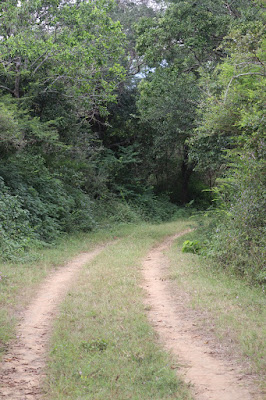The Puckle’s Path
The Puckle’s Path
Thalavai pandi S
 |
| Puckle's path Photo : Maria Antony |
Students from the
Corpus Christi School, Nagercoil attended the wild camp to learn about flora
and fauna present in a forest ecosystem. We had our breakfast at the dormitory
to reduce the weight of the luggage and started hiking the puckle’s path by
seven in the morning. Puckle’s path is one of the scenic trekking routes at
Kalakkad Mundanthurai Tiger Reserve. It is named after the then British
collector Puckle who used to ride this particular trail. The trial is well-made
and wide enough to even ride a four-wheeler. The remnants of a dairy farm once
operated during the British period was also visible. There are several small
streams that cross the path, which comes alive during the monsoon.
 |
| Brown-headed Barbet Photo: Prasanth |
On our way, we were
welcomed by the calls of Coppersmith Barbet, Brown-headed barbet and jungle
fowl. As usual, we started with the introduction of the path and Boothaththan,
an experienced retired watcher accompanied us who explained several interesting
pieces of information about this path. The activity of the birds was good but I
tried to concentrate more on insects. Small minivet was grooming its feather on
a dry tree which was very visible to us. As we moved further whatever organisms
we came across on the trail we explained to the students about their distinct
characteristics. We observed the flying pattern of the common sailor butterfly
near the grass where Antony found the adult Antlion. He caught it and explained
the lifecycle of it, the reason behind its name and released back at the same
place.
 |
| Strobilanthus sp., Photo: Thalavai pandi S |
We came across a camera
trap set up by the forest department. We explained the importance of such types
of equipment in wildlife population estimation and monitoring inside the
forest. Several florae have bloomed on both sides of the path such as Strobilanthus, Barleria, Jasminum,
Crotalaria, Plumbago zeylanica, Aglaia, etc. Botanist Saravanan explained a
few taxonomies to the children. At that time, we saw a Plum-headed parakeet and
a Golden Oriole on a dry tree, grooming their feathers. We observed a juvenile
of a Garden Lizard which was basking on a small shrub, also a Tiger centipede
moving on the side of the trek path. We saw the fresh scat of Indian porcupine
on the path, it might be from the previous night. One of the students was
keenly observing the survival technique of Stick insect. All the streams got
dried up except two small ones, indicating that the summer season has started.
We saw a few fishes jumping in small pools which had very less water. One of
the students collected a few of these fishes and left it in the nearby stream.
 |
| Excretion of Indian Porcupine |
The climate was cloudy
during the whole hike, so we saw only around 25 species of butterflies
including Blue Mormon which is India's second-largest butterfly and the state
butterfly of Maharastra, Malabar spotted flat, Indian Cupid, etc and different
types of moths and caterpillar, grasshoppers and nymphs. The funnel spider was
patiently waiting on the web for its prey. As we neared the end of the trail,
we saw the eggs of Jungle fowl. The hike ended at Servalar river where all of us
had a good bath and we also finished our lunch. After lunch, we proceeded to
another trail where students learnt about the different types of leaves and
barks pattern associated with trees. Afterwards, we visited the tribal
settlement where the children interacted with the people learning their ways of
living inside the forest, how it used to be and how it has changed in recent
times.
 |
| Dark Wanderer Photo: Thalavai pandi S |
On returning to the
dormitory, movie “Wild Karnataka” was screened. After the movie screening we
setup the moth screen and explained the different types of moths that got
attracted towards the mercury lamp. Initially, there were very few moths but
thanks to the night drizzle, by four in the morning we found nearly 15 families
of moths including Sphingidae, Erebidae, Crambidae, Pyralidae, etc. Other than
moths there were also a lot of other insects such as Caddisfly, Mayfly, Beetle,
different types of mantis and Grasshoppers.
 |
| Moth - Nyctemera lacticinia |
In the morning we
initially planned to go for a short walk on the road to observe the animals
that might have got killed by the speeding vehicles. But at the last moment,
the activity was cancelled due to rain. So we had our breakfast at the forest
department canteen and went for butterfly watching activity on a different
trail. As the climate was cloudy even today, we could not find many
butterflies. We saw a few including Blue Mormon, Psyche, Common Grass Yellow,
Water Snow Flat and Dark Cerulean. We hiked for a small distance and the rain
has started again. So we decided to head back and on our way back we saw a
Hump-nosed pit viper on the path.
 |
| Hump-nosed pit viper |
At the end of the day, we saw nearly 35
different types of butterflies. We visited the picturesque Karaiyar dam and
took a group photo and returned to the room. With the valedictory ceremony this
three-day, two-night camp came to an end. Overall we had a nice experience and
learnt a lot from this wild camp.



Comments
Post a Comment